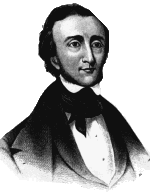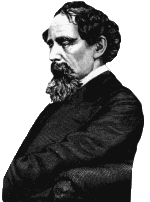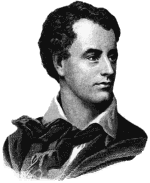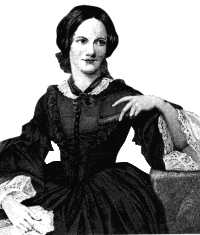Welcome to Valerie's Homepage!!
THANKS FOR VISITING MY WEBSITE.
I GUARANTEE YOU'LL HAVE A MARVELOUS EXPERIENCE!
WELCOME TO LITERATUREEMAIL VALERIEE
BOOK LOVERS
 |

| 
|

| 
|
EDGAR ALLAN POE
INTRODUCTION POETRY AND ESSAYS STORIES CHARLES JOHN HUFFAM DICKENS
INTRODUCTION EARLY YEARS LITERARY CAREER EARLY FICTION MATURE FICTION FINAL YEARS ACHIEVEMENT GEORGE GORDON NOEL BYRON
INTRODUCTION FAME AND MARRIAGE EXILE THE BRONTE SISTERS
INTRODUCTION CHARLOTTE BRONTE "Poe, Edgar Allan," Microsoft® Encarta® Online Encyclopedia 2002
http://encarta.msn.com © 1997-2002 Microsoft Corporation. All Rights Reserved.
© 1993-2002 Microsoft Corporation. All Rights Reserved.
Contributed by: Laurie Langbauer, B.A, M.A., Ph.D. Professor of English, University of North Carolina. Author of Novels of Everyday Life:The Series in English Fiction, 1850-1930
"Dickens, Charles John Huffam," Microsoft® Encarta® Online Encyclopedia 2002
http://encarta.msn.com © 1997-2002 Microsoft Corporation. All Rights Reserved.
© 1993-2002 Microsoft Corporation. All Rights Reserved.
"Byron, George Gordon Noel, 6th Baron Byron," Microsoft® Encarta® Online Encyclopedia 2002
http://encarta.msn.com © 1997-2002 Microsoft Corporation. All Rights Reserved.
© 1993-2002 Microsoft Corporation. All Rights Reserved.
Contributed by: Walter Allen, B.A. Former C.P. Miles Professor of English, Virginia Polytechnic Institute. Author of The English Novel and The Short Story in English.
"Brontë," Microsoft® Encarta® Online Encyclopedia 2002
http://encarta.msn.com © 1997-2002 Microsoft Corporation. All Rights Reserved.
© 1993-2002 Microsoft Corporation. All Rights Reserved.
Born in Boston, Massachusetts, Poe was orphaned in his early childhood and was raised by John Allan, a successful businessman of Richmond, Virginia. Taken by the Allan family to England at the age of six, Poe was placed in a private school. Upon returning to the United States in 1820 he continued to study in private schools. He attended the University of Virginia for a year, but in 1827 his foster father displeased by the young man's drinking and gambling refused to pay his debts and forced him to work as a clerk.
Poe, disliking his new duties intensely, quit the job thus estranging Allan and went to Boston. There his first book "Tamerlane" and "Other Poems"1827 was published anonymously. Shortly afterward Poe enlisted in the U.S. Army and served a two-year term. His second volume of verse "Al Aaraaf" 1829 was published and he effected a reconciliation with Allan who secured him an appointment to the U.S. Military Academy. After only a few months at the academy Poe was dismissed for neglect of duty and his foster father disowned him permanently.
Poe's third book "Poems" 1831 and the following year he moved to Baltimore where he lived with his aunt and her 11-year-old daughter Virginia Clemm. The following year his tale "AMS, Found in a Bottle" 1832 won a contest sponsored by the Baltimore Saturday Visitor. From 1825-1837 Poe was an editor of the Southern Literary Messenger. In 1836 he married his young cousin. Throughout the next decade much of which was marred by his wife's long illness Poe worked as an editor for various periodicals in Philadelphia, Pennsylvania, and in New York City. In 1847 Virginia died and Poe himself became ill; his disastrous addiction to liquor and his alleged use of drugs recorded by contemporaries may have contributed to his early death.
In the course of his editorial work Poe functioned largely as a book reviewer and produced a significant body of criticism; his essays were famous for their sarcasm, wit and exposure of literary pretension. His evaluations have withstood the test of time and have earned for him a high place among American literary critics. Poe's theories on the nature of fiction and his writings on the short story have had a lasting influence on American and European writers.
Many of Poe's tales are distinguished by the author's unique grotesque inventiveness in addition to his superb plot construction. Such stories include "The Narrative of Arthur Gordon Pym" 1838 noted for its blend of factual and fantastic material; "The Fall of the House of Usher" 1839 in which the penetrating gloominess of the atmosphere is accented equally with plot and characterization; "The Pit and the Pendulum" 1842 a spine-tingling tale of cruelty and torture; "The Tell-Tale Heart" 1843 in which a maniacal murderer is subconsciously haunted into confessing his guilt; and "The Cask of Amontillado" 1846 an eerie tale of revenge. On the morning of October 7, 1849 he died.
Dickens's novels criticize the injustices of his time especially the brutal treatment of the poor in a society sharply divided by differences of wealth. But he presents this criticism through the lives of characters that seem to live and breathe. Paradoxically, they often do so by being flamboyantly larger than life: the 20th-century poet and critic T.S. Eliot wrote, "Dicken's characters are real because there is no one like them." Yet though the sentimental, grotesque and humorous few authors match Dickens's psychological realism and depth. Dicken's novels rank among the funniest and most gripping ever written among the most passionate and persuasive on the topic of social justice and among the most psychologically telling and insightful works of fiction. They are also some of the most masterful works in terms of artistic form including narrative structure repeated motifs, consistent imagery, juxtaposition of symbols, stylization of characters and settings and commmand of language.
Dickens established (and made profitable) the method of first publishing novels in serial installments in monthly magazines. He thereby reached a larger audience including those who could only afford their reading on such an installment plan. This form of publication soon became popular with other writers in Britain and the United States.
The family's increasing poverty forced Dickens out of school at age 12 to work in Warren's Blacking Warehouse, a shoe-polish factory where the other working boys mocked him as "the young gentleman." His father was then imprisoned for debt. The humiliations of his father's imprisonment and and his labor in the blacking factory formed Dickens's greatest wound and became his deepest secret. He could not confide them even to his wife although they provide the unacknowledged foundation of his fiction.
Soon after his father's release from prison Dickens got a better job as errand boy in law offices. He taught himself shorthand to get an even better job later as a court stenographer and as a reporter in Parliament. At the same time Dickens who had a reporter's eye for transcribing the life around him especially anything comic or odd, submitted short sketches to obscure magazines. The first published sketch "A Dinner at Poplar Walk"(later retitled "Mr. Minns and His Cousin") brought tears to Dickens's eyes when he discovered it in the pages of "The Monthly Magazine" in 1833. From then on his sketches which appeared under the pen name "Boz" (rhymes with "rose") in "The Evening Chronicle" earned him a modest reputation. Boz originated as a childhood nickname for Dickens's younger brother Augustus.
Dickens became a regular visitor at the home of George Hagarth, editor of The Evening Chronicle and in 1835 became engaged to Hogarth's daughter Catherine. Publication of collected Sketches by Boz in 1836 gave Dickens sufficient income to marry Catherine Hogarth that year. The marriage proved unhappy.
The runaway success of "The Pickwick Papers" as it is generally know today clinched Dickens's fame. There were Pickwick coats and Pickwick cigars and the plump, spectacled hero, Samuel Pickwick, became a national fiqure. Four years later Dickens's readers found Dolly Varden, the heroine of "Barnaby Rudge" 1841 so irresistible that they named a waltz, a rose and even a trout for her. The widespread familiarity today with "Ebenezer Scrooge" and his proverbial hard-heartedness from "A Christmas Carol" 1843 demonstrate that Dickens's characters live on in the popular imagination.
Dickens published 15 novels, one of which was left unfinished at his death. These novels are, in order of publication with serialization dates given first: "The Posthumous Papers of the Pickwick Club"1836-1837; "The Adventures of Oliver Twist" 1837-1839; "The Life and Adventures of Nicholas Nickleby" 1838-1839; "The Old Curiosity Shop" 1840-1841; "Barnaby Rudge" 1841; "The Life and Adventures of Martin Chuzzlewit" 1843-1844; "Dombey and Son" 1846-1848; "The Personal History of David Copperfield" 1849-1850; "Bleak House" 1852-1853; "Hard Times" 1854; "Little Dorrit" 1855-1857 "A Tale of Two Cities" 1859; "Great Expectation" 1860-1861; "Our Mutual Friend" 1864-1865; and "The Mystery of Edwin Drood" (unfinished; 1870).
Through his fiction Dickens did much to highlight the worst abuses of the 19th-century society and to prick the public conscience. But running through the main plot of the novels are a host of subplots concerning fascinating and sometime ludicrous minor characters. Much of the humor of the novels derives from Dickens's descriptions of these characters and from his ability to capture their speech mannerisms and idiosyncratic traits.
"The Pickwick Papers" for example is a wandering comic epic in which Samuel Pickwick acts as a plump and cheerful Don Quixote, and Sam Weller as a cockney version of Quixote's knowing servant, Sancho Panza. The novel's preposterous characters high spirits and absurd adventures delighted readers. After Pickwick, Dickens plunged into a bleaker world. In
The "Old Curiosity Shop" broke hearts across Britain and North America when it appeared. Later readers however have found it excessively sentimental especially the pathos surrounding the death of its child-heroine Little Nell. Dickens's next two works proved less popular with the public. "Barnaby Rudge" Dickens's first historical novel revolves around anti-Catholic riots that broke out in London in 1780. The events in "Martin Chuzzlewit" became a vehicle for the novel's theme: selfishness and its evils. The characters especially the Chuzzlewit family present a multitude of perspectives on greed and unscrupulous self-interest. Dickens wrote it after a trip to the United States in 1842.
Dickens always considered "David Copperfield" to be the best novel and the one he most liked. The beginning seems to be autobiographical with David's childhood experiences recalling Dickens's own in the blacking factory. The unifying theme of the book is the "undisciplined heart" of the young David which leads to all the mistakes including the greatest of them his mistaken first marriage.
"Bleak House" ushers in Dickens's final period as a satirist and social critic. A court case involving an inheritance forms the mainspring of the plot and ultimately connects all of the characters in the novel. The dominant image in the book is fog which envelops, entangles, veils and obscures. The fog stands for the law, the courts vested interests, and corrupt institutions. Dickens had a long-standing dislike of legal system and protracted lawsuits from his days as a reporter in the courts.
A novel about industry, "Hard Times" followed "Bleak House" in 1854. In "Hard Times" Dickens satirizes the theories of political economists through exaggerated characters such as Mr. Bounderby, the self-made man motivated by greed and Mr. Gradgrind, the schoolmaster who emphasizes facts and figures over all else. In Bounderby's mines, lives are ground down; in Gradgrind's classroom imagination and feelings are strangled.
The pervading image of "Little Dorrit" is the jail. Dickens's memory of his own father's time debtors' prison adds an autobiographical touch to the novel. "Little Dorrit" also contains Dickens's invention of the Circumlocution Office, the archetype of all bureaucracies, where nothing ever gets done. Through this critique and others, such as the circular legal system in "Bleak House", Dickens also investigated by ways in which art makes meaning and the workings of his own narrative style.
"A Tale of Two Cities", is set in London and Paris during the "French Revolution" 1789-1799. It stands out among the novels as a work driven by incident and event rather than by character and is critical both of the violence of the mob and of the abuses of the aristocracy, which prompted the revolution. The successful "Tale of Two Cities" was soon followed by "Great Expectations" which marked a return to the more familiar Dickensian style of character-driven narrative. Its main character Pip, tells his own story. Pip's "great expectations" are to lead an idle life of luxury. Through Pip, Dickens exposes that ideal as false.
Dickens's last complete novel is the dark and powerful "Our Mutual Friend". A tale of greed and obsession, it takes place in an ill-lit and dirty London, with images of darkness and decay throughout. Only 6 of the 12 intended parts of "Edwin Drood" has been completed by the time Dickens died. He intended it as a mystery story concerning the disappearance of the title character.
Following the separation, Dickens continued his hectic schedule of novel, story, essay and letter writing (his collected letters) alone stretch thousands of pages; reform activities; amateur theatricals and readings; in addition to nightly social engagements and long midnight walks through London. His energy had always seemed to his friends inhuman, but he maintained this activity in his later years in desregard of failing health. Dickens died of a stroke shortly after his farewell reading tour while writing "The Mystery of Edwin Drood".
British writer George Orwell felt that Dickens was not a revolutionary, however, despite his criticism of society's ills. Orwell points out that Dickens "has no constructive suggestions not even a clear grasp of the nature of the society he is attacking, only an emotional perception that something is wrong." That instinctive feeling becomes so moving in the novels because Dickens made the injustices he hated concrete and specfic, not abstract and general. His readers feel the abuses of the 19th-century society as real through the life of his characters. Underlying and reinforcing that illusion of reality however, is a rich and complicated system of symbolic imagery resulting from superb artistry.
Through his characters, Dickens, also touched a range of readers which was perhaps his greatest talent. As his friend John Forster wrote, his stories enthralled "judges on the bench and boys in the street" alike. The illiterate often too poor to buy installments themselves pooled their pennies and got someone to read aloud to them.
Near the end of the serialization of "The Old Curiosity Shop", crowd thronged to a New York pier to await the ship from London carrying the lastest installment. As it came to the dock people roared "Is Little Nell dead?" The pathetic death of the novel's child-heroine, Nell Trent, became one of the most celebrated scenes in the 19th century fiction. Such public concern over Little Nell's end guaranteed that Dickens's social message would be heard, not only by his avid readers, but also by those in power.
Dickens was a careful craftsman, with a strong sense of design; his books were strictly outlined. Any current notions that Dickens's novels are long because he was paid by the word, or sloppy because he wrote them under pressure of monthly deadlines, are simply untrue. What organizes Dickens's stories is sometimes not apparent at first glance, although it makes sense in novels that emphasize character. It is the logic of psychology, the tensions and contradictions of our drives and emotions, which Dickens plumbed, laying side by side the best and the worst of the human heart. This is a very different logic from the order of realism that rests on common sense. Dickens detested common sense, seeing in its seeming obviousness a form of tyranny.
The theater was a crucial influence of Dickens's work. As a young man Dickens tried to go on stage, but he missed his audition because of a cold. Not only did Dickens later write comic plays, melodramas, and "libretti" (words for musical dramas), he was also often involve in amateur theatricals for good causes, and spent his last two decades reading his own stories to packed audiences. Dickens's readings were as much a sensation in England and America as was his writing, and they proved as profitable. The readings revealed the part of the man that made him a practiced magician and hypnotist as well.
Dickens's love of the theatrical makes his works lend themselves readily to media adaptations. Motion picture or television versions exist for almost every one of them. "A Christmas Carol" was one of the earliest to be adapted, first appearing as the silent film "Scrooge" , 1901 directed by Walter R. Booth. The most notable adaptations include "A Christmas Carol", 1938 directed by Edwin L. Marin and starring Reginald Owen, and, probably the most famous of all, "A Christmas Carol" 1951) directed by Brian Desmond Hart and starring Alastair Sim. A later production titled "Scrooged", 1988 was directed by Richard Donner and starred Bill Murray. David Lean directed the most famous of the many versions of "Great Expectations", 1946. The film "Oliver!" , 1968 a musical based on Oliver Twist and directed by Carol Reed, won six Academy Awards. Nowadays people are probably more familiar with the many BBC television miniseries productions of Dickens's works.
In 1822, with the poets "Percy Bysshe Shelley and Leigh Hunt", he started at Pisa a journal called "The Liberal", but Shelley's death that year and a quarrel with Hunt put an end to this venture after only three issues had been printed. "Don Juan", a mock epic in 16 cantos, encompasses a brilliant satire on contemporary English society. Often regarded as Byron's greatest work, it was completed in 1823. At the news of the revolt of the Greeks against the Ottoman Empire Byron, disregarding his weakened physical condition, in July 1823 joined the Greek insurgents at Mesolongion (Missolonghi). He not only recruited a regiment for the cause of Greek independence but contributed large sums of money to it. The Greeks made him commander in chief of their forces in January 1824. The poet died at Mesolongion three months later.
The Bronte children's imaginations transmuted a set of wooden soldiers into characters in a series of stories they wrote about the imaginary kingdom of Angria-the property of Charlotte and Branwell-and the kingdom of Gondal-whiched belonged to Emily and Anne. A hundred tiny handwritten volumes started in 1829, of the chronicles of Angria survive, but nothing of the Gondal saga started in 1831, except some of Emily's poems. The relationship of these stories to the later novels is a matter of much interest to scholars.
Charlotte's discovery of Emily's poems led to the decision to have the sisters's verses published; these appeared, at their own expense, as "Poems by Currer, Ellis and Acton Bell", 1846 each sister using her own initals in these pseudonyms. Two copies were sold.
Each sister then embarked on a novel. Charlotte's "Jane Eyre" were published first, in 1847; Anne's "Agnes Grey" and "Emily's Wuthering Heights" appeared a little later that year. Speculation about the authors' identities was rife until they visited London and met their publishers.
On their return to Haworth they found Branwell near death. Emily caught cold at his funeral, and died December 19, 1848. Anne too died, on May 28, 1849. Her second novel, "The Tenant of Wildfell Hall", had been published the year before; the account of a drunkard's degeneration, it was as deeply rooted in personal observation as "Agnes Grey", the study of a governess's life.
Alone now with her father at Haworth, Charlotte resumed work on the novel"Shirley" 1849. This was the least successful of her novels, althought its depiction of the struggle between masters and workers in the Yorkshire weaving industry a generation earlier precluded Charlotte's relying solely on intense subjectivity. This strain of realism was the source of her power, as can be ssen earlier in "Jane Eyre" and later in "Villette and The Professor,1857. In 1854, Charlotte married her father's curate, Arthur Bell Nicholls. Pregnant in 1855, she became ill and died March 31 of that year of tuberculosis.
Since their deaths, new generations of readers have been fascinated by the curcumstances of the Brontes' lives, their untimely deaths, and their astonishing achievements. "Jane Eyre's popularity has never waned; it is a passionate expression of female issues and concerns. The Brontes's transcendent masterpiece, however, is almost certainly Emily's novel "Wuthering Heights", a story of passionate love, in which irreconcilable principles of energy and calm are ultimately harmonized. Emily Bronte was a mystic, as her poetry shows, and "Wuthering Heights" dramatizes her intuitive apprehension of the nature of life.
The first book about the Brontes, "The life of Charlotte Bronte", 1857 by her friend the novelist Elizabeth Gaskell, is a classic biography. Another notable book is Fannie E. Ratchford's "The Brontes' Web of Childhood", 1941; it first indicated the significance of their art of the Angria and Gondal sagas of their childhood.